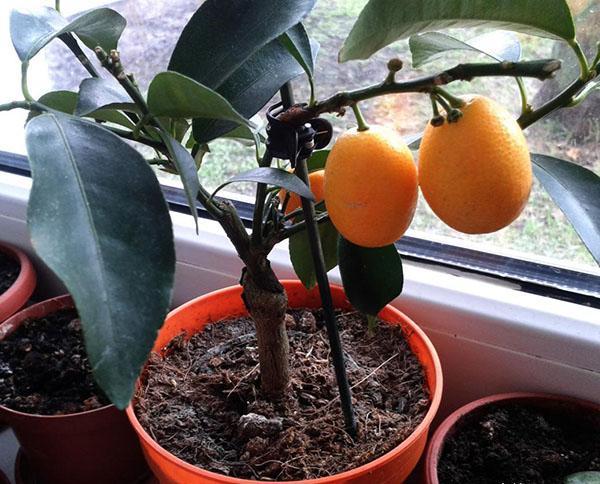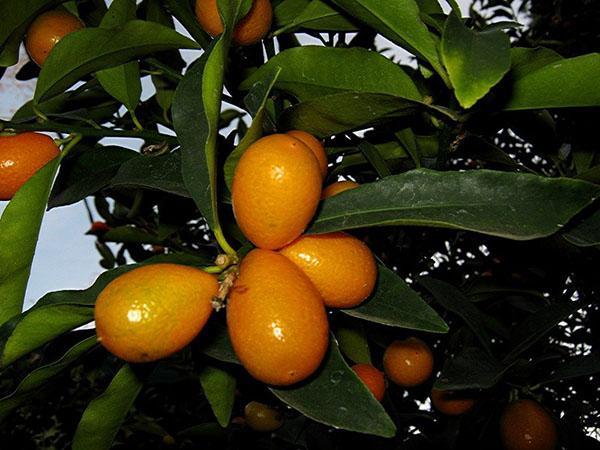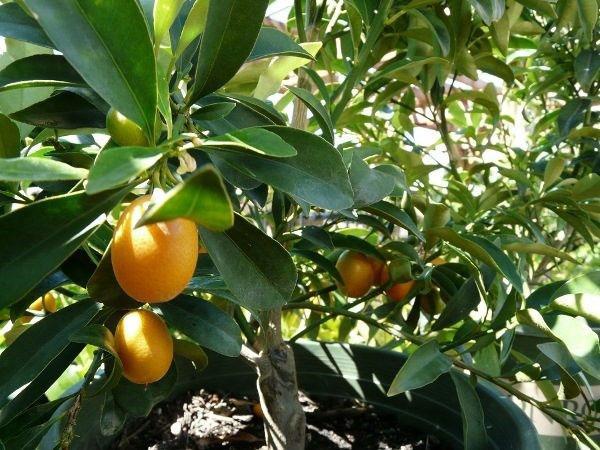Kumquat at home: features of growing and reproduction
 The kumquat, "golden orange" or kinkan are an attractive houseplant with tropical orange fruits. Kumquat at home looks aesthetically attractive, resembles a small tree or bonsai with an evergreen crown. The beneficial properties and taste of the fruit are in no way inferior to the well-known citrus fruits. If necessary, the plant can be shaped like a shrub, the height of which will depend on the size of the flowerpot. At home, an exotic tree will delight the eye if provided with suitable conditions.
The kumquat, "golden orange" or kinkan are an attractive houseplant with tropical orange fruits. Kumquat at home looks aesthetically attractive, resembles a small tree or bonsai with an evergreen crown. The beneficial properties and taste of the fruit are in no way inferior to the well-known citrus fruits. If necessary, the plant can be shaped like a shrub, the height of which will depend on the size of the flowerpot. At home, an exotic tree will delight the eye if provided with suitable conditions.
Read also the article: myrtle - home care (photo of dry leaves)
Description of the plant

The dense crown is strongly branched, the branches are densely covered with small smooth dark green leaves. When growing kumquat at home, the flowering period begins in April or late May and lasts up to 50 days. The flowers have a pleasant aroma, are painted white with a pale pink tint, can be located both in inflorescences and singly.
In 60 - 90 days after flowering, the plants begin to bear fruit. Full ripening of the fruits occurs by the beginning of spring. During this period, the tree looks especially attractive. The fruits are similar to small oranges weighing up to 30 g, the peel is thin, has a bright orange color. The flesh tastes sour, and the skin is sweet, so you can leave it on.
Kumquat varieties suitable for home growing
Almost all types of kinkan that grow in nature are also suitable for independent cultivation. Several varieties are most popular with specialists and amateurs.
Nagami
 The most common type that is actively used by designers and flower growers. Brings sweet fruits, similar in size and shape to olives. Nagami has several subspecies:
The most common type that is actively used by designers and flower growers. Brings sweet fruits, similar in size and shape to olives. Nagami has several subspecies:
- Variegatum. Differs in original stripes on the fruit; after ripening, the decorative effect disappears.
- Nordmann. Seedless plant variety.
Nagami is often used in bonsai art.
Marumi
 The Japanese cultivar, kumquat, is a small, thorny shrub. The fruits are oval in shape, colored in a golden orange hue. They have a noble, sweet taste. Marumi tolerates frost well, so in the southern regions it can be grown outdoors.
The Japanese cultivar, kumquat, is a small, thorny shrub. The fruits are oval in shape, colored in a golden orange hue. They have a noble, sweet taste. Marumi tolerates frost well, so in the southern regions it can be grown outdoors.
Meiva
 A dwarf variety with high decorative properties. Quite large yellow-orange fruits are similar to lemons, taste with a slight sourness. The plant is short, has oval leaves and a dense crown, which can decorate any interior.
A dwarf variety with high decorative properties. Quite large yellow-orange fruits are similar to lemons, taste with a slight sourness. The plant is short, has oval leaves and a dense crown, which can decorate any interior.
Fukushi

This variety is characterized by the largest and sweetest fruits with a thin skin. The dense, branchy crown will be an excellent option for use in greenhouses and conservatories.
Before buying a tree, you need to learn how to care for a kumquat. For growing in indoor conditions, not only varieties of kinkan are suitable, but also various hybrids of some citrus and kumquat: with tangerine (calamondin), lemon (lemonquat), lime (limequat) and others.
Kumquat at home: growing and care
 Proper plant maintenance requires care and work. Like any citrus fruit, it reacts very sensitively to unfavorable conditions, therefore, it needs increased attention and regular care. The capricious kinkan is attractive and bears a lot of fruit. Despite all the difficulties, growing kumvat at home will be a fun and enjoyable experience.
Proper plant maintenance requires care and work. Like any citrus fruit, it reacts very sensitively to unfavorable conditions, therefore, it needs increased attention and regular care. The capricious kinkan is attractive and bears a lot of fruit. Despite all the difficulties, growing kumvat at home will be a fun and enjoyable experience.
Location and lighting
 To install the flowerpot, the sunniest place in the apartment is selected - window sills located on the west or south side. When placed by a window facing east, the tree will live, but develop slowly and bear little fruit. In the summer, the plant will need diffused light and protection from direct rays. You can take it out onto the balcony or outside.
To install the flowerpot, the sunniest place in the apartment is selected - window sills located on the west or south side. When placed by a window facing east, the tree will live, but develop slowly and bear little fruit. In the summer, the plant will need diffused light and protection from direct rays. You can take it out onto the balcony or outside.
Suitable temperature indicators in summer are 25 - 28 degrees, in winter +10 - +12. Strong heat or, conversely, hypothermia should not be allowed. In the cold season, the plant should be kept quiet. To do this, it is located in a cool place, while watering is reduced. This will help prepare the home kumquat plant for further development, flowering and harvest formation.
If the wintering site is warm, the tree will need more light. A warm microclimate combined with poor lighting will lead to leaf fall. After that, the plant is difficult to restore.
Air humidity and watering
 The tree loves high humidity, grows faster and bears fruit better under favorable conditions. It is enough to place it in a wide pan with wet expanded clay, spray it with water or use special humidifiers. It is useful for adult plants to take a bath from time to time in the shower, as well as wiping the leaves with a damp sponge.
The tree loves high humidity, grows faster and bears fruit better under favorable conditions. It is enough to place it in a wide pan with wet expanded clay, spray it with water or use special humidifiers. It is useful for adult plants to take a bath from time to time in the shower, as well as wiping the leaves with a damp sponge.
Caring for a kumquat at home is not complete without regular abundant watering. The water should be settled and soft. Hard running moisture will have to be slightly acidified 1 - 2 days before watering, so that all harmful salts will settle. It is important to monitor the acidity of the soil, which should be almost neutral.
The time of year depends on the frequency of watering: in the summer heat, the plant often needs moisture, in winter - much less often. About the need glaze can be recognized by the condition of the soil. If it has dried more than 4 cm, it's time to use soft or acidified water. In cold weather at temperatures up to +10 degrees, the strait is made once a month.
The tree does not tolerate both deficiency and excess moisture. Flooded roots are prone to decay, overdried soil will lead to the death of a kinkan. Excess water that has leaked onto the pan is completely drained after half an hour.
Pruning and replanting
 Trees and shrubs grown from seeds are sometimes tall and branched. To form a beautiful crown and maintain its presentable appearance, the kumquat is pruned. The procedure is repeated annually, in the spring. The tips of the shoots are carefully removed so that the crown takes the shape of a semicircle. Pruning is performed not only for aesthetic purposes, but also activates the growth of new branches, which has a beneficial effect on productivity.
Trees and shrubs grown from seeds are sometimes tall and branched. To form a beautiful crown and maintain its presentable appearance, the kumquat is pruned. The procedure is repeated annually, in the spring. The tips of the shoots are carefully removed so that the crown takes the shape of a semicircle. Pruning is performed not only for aesthetic purposes, but also activates the growth of new branches, which has a beneficial effect on productivity.
 A kumquat that bears fruit needs to be transplanted once every 2 to 3 years. It should be produced before the growth of new shoots - at the end of winter or at the very beginning of spring. The process consists in transferring the plant along with a lump of soil, while it is important not to touch the fragile root system.
A kumquat that bears fruit needs to be transplanted once every 2 to 3 years. It should be produced before the growth of new shoots - at the end of winter or at the very beginning of spring. The process consists in transferring the plant along with a lump of soil, while it is important not to touch the fragile root system.
After transplanting, the flowerpot is placed in a place sheltered from the rays of the sun. Kumvat is sprayed with water every day.
Fertilization
 Without a regular supply of nutrients, the plant will not bear fruit, so it is important to consider this aspect of care. Based on several factors, the frequency of application of food is revealed:
Without a regular supply of nutrients, the plant will not bear fruit, so it is important to consider this aspect of care. Based on several factors, the frequency of application of food is revealed:
- age and condition of the kinkan;
- features of the soil in which the tree grows;
- the size of the flowerpot.
If the pot is small, then fertilizer should be applied more often. At the stage of active growth potash and phosphorus fertilizing is applied every 10 days. In winter, the procedure is reduced to 1 time per month.
Fertilizers are important for the normal development of the kinkan as well as high yields. A suitable amount per liter of water is:
- potassium chloride - 1/8 tsp;
- ammonium nitrate - ¼ tsp;
- simple superphosphate - 0.5 tsp.
Some growers dealing with the problem of how to grow a kumquat at home, note a positive effect after making an infusion from wood ash.
Plant propagation
Reproduction of kumquat is carried out in several ways:
- bone;
- cuttings;
- ringing sprouts;
- vaccination.
The last two methods are difficult to perform, therefore only experienced florists can do it. Beginners are advised to pay attention to two other methods. Let's consider each of them in more detail.
Bone propagation
 It is considered the most affordable and popular way. Growing a kumquat from a stone at home is a very real task, but the tree will grow for a long time, and the first fruits will appear on it only in the 10th year.
It is considered the most affordable and popular way. Growing a kumquat from a stone at home is a very real task, but the tree will grow for a long time, and the first fruits will appear on it only in the 10th year.
Fresh seed is soaked in a root solution for several days, then planted in the central part of the pot to a depth of 1.5 - 2 cm. For planting, a universal soil consisting of sand and black soil is suitable. The seed is watered with a large amount of water, the excess of which is drained from the pan. The pot is covered with a piece of glass or plastic wrap, then placed in a well-lit, cool place.
After a couple of months, seedlings appear with 4 - 5 leaves. After that, a transplant is made into a more spacious flowerpot. Citrus kumquat should be looked after as well as mature trees.
Cuttings
 For the procedure, you will need a 10-centimeter branch of a healthy plant. Several leaves should be located on the handle, the cut is made from top to bottom along an oblique line. It is worth doing this in April, before the flowers appear. Otherwise, the seedling will take root for a long time and hurt.
For the procedure, you will need a 10-centimeter branch of a healthy plant. Several leaves should be located on the handle, the cut is made from top to bottom along an oblique line. It is worth doing this in April, before the flowers appear. Otherwise, the seedling will take root for a long time and hurt.
For effective propagation of kumquat by cuttings, the branch is covered with a special growth stimulant. The surface of the lower cut is sprinkled with wood ash, then the cutting is planted in a suitable container with soil and covered with a glass vessel. The flowerpot is located in a well-lit place, airing and watering are periodically carried out. After 2 months, the plant is fully prepared for rooting.
Layers
To create a layering when growing a kumquat at home, it is necessary to choose a shoot up to 20 cm long on an adult plant.In the middle of the sprout, two bark incisions are made at a distance of 1 cm from each other. The bark is carefully removed, as a result of which a bare round area is formed on the branch. The foliage under the ring is removed and a piece of bark is placed in the soil.
You will need a plastic bottle or paper bag for layering. The container should be cut into two parts, and a hole should be cut at the bottom corresponding to the diameter of the shoot. The branch is placed inside the bottle, and both parts are held together with tape. A wet mixture of peat and sand is poured into the container. It is important to ensure that the soil does not dry out.
Over time, a new rhizome forms on the branch, and after a couple of months the shoot can be cut off and the bottle removed. The kumquat is being transplanted into a new flowerpot.
Graft
 This method will require plant seedlings that have reached a thickness of 1 cm. Experts recommend grafting a kumquat on a poncirus or grapefruit stock.
This method will require plant seedlings that have reached a thickness of 1 cm. Experts recommend grafting a kumquat on a poncirus or grapefruit stock.
The procedure is carried out at the stage of active growth and movement of juices along the shoots. After 1.5 months, the eyes take root, and the shoots located above the grafting are cut off for a full crown design.
A kumquat grown in this way begins to bear fruit somewhat later, but the development of a tree is much faster.The grafted plants are highly resistant to various negative factors.
Pests and diseases
 The kumquat is characterized by the same diseases as all citrus fruits. The main pathological signs include:
The kumquat is characterized by the same diseases as all citrus fruits. The main pathological signs include:
- the appearance of spots on the leaves;
- blizzard frequency of shoots;
- change in the color and shape of foliage;
- the formation of growths;
- drying out.
The plant often suffers from a bacterial or fungal infection, but it is quite possible to cure it. Existing fruits and buds are removed so that the kumquat does not lose its strength. After that, repeated treatment with fungicidal preparations is carried out. At the stage of treatment, it is important to provide the plant with full care and attention so that it quickly regains its vitality.
Trispes viruses, xyloporosis and some others cannot be cured. In the presence of an unfavorable microclimate, the tree is attacked by spider mites, aphids, scale insects and other pests. You can fight them with the help of special means.
Kumquat is an attractive plant suitable for growing at home. With proper care, it will delight the eye and produce healthy fruits with exquisite taste.